| |
|
Xiamen Oil Paintings, Wholesale Direct!
|
|
100% hand painted, 100% cotton canvas, 100% money back if not satisfaction. |
|
|
|
|
ART WORKS INDEX
A
B
C
D
E
F
G
H
I
J
K
L
M
N
O
P
Q
R
S
T
U
V
W
X
Y
Z
|
|
ARTISTS INDEX
A
B
C
D
E
F
G
H
I
J
K
L
M
N
O
P
Q
R
S
T
U
V
W
X
Y
Z
|
|
|
|
|
|
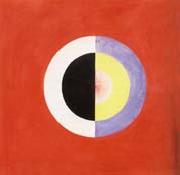 |
Hilma af Klint
|
|
1862 - 1944,was a Swedish artist and mystic whose paintings were amongst the first abstract art. She belonged to a group called 'The Five' and the paintings or diagrams were a visual representation of complex philosophical ideas. The fourth child of Captain Victor af Klint, a Swedish naval commander, and Mathilda af Klint (n??e Sonntag), Hilma af Klint spent summers with her family at their farm Hammora on the island of Adelsö in Lake Mälaren. In these idylic surroundings Hilma came into contact with nature at an early stage in her life and this deep association with natural forms was to be an inspiration in her work. From her father she adopted an interest in mathematics. In 1880 her younger sister Hermina died and it was at this time that the spiritual dimension of her life began to develop. She showed an early ability in visual art and after the family had moved to Stockholm she studied at the Academy of Fine Arts for five years during which time she learned portraiture and landscape painting . Here she met Anna Cassel, the first of the four women with whom she later worked in 'The Five' (de fem), a group of artists who shared her ideas. Her more conventional painting became the source of her financial income while the 'life's work' remained a quite separate practice.
|
|
|
|
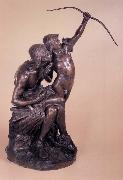 |
Hermon Atkins Macneil
|
|
American Sculptor, 1866-1947,American sculptor, b. Chelsea, Mass., studied in Paris and in Rome. His first work of importance was for the World's Columbian Exposition, Chicago, 1893, but he is perhaps best known for his Native Americans and Western pioneers. Among his monuments are The Coming of the White Man (Portland, Oreg.); the McKinley Memorial (Columbus, Ohio); the Soldiers and Sailors Monument (Albany, N.Y.); and the Marquette Memorial (Chicago). Among smaller sculptures is The Sun Vow (Metropolitan Mus.).
|
|
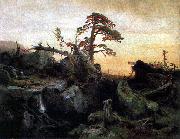 |
Hermann August Cappelen
|
|
(1 May 1827 - 8 March 1852) was a Norwegian painter. Cappelen was best known for his melancholic, dramatic and romantic landscape compositions.
Hermann August Cappelen was born in Skien, Norway. He was the son of Diderik von Cappelen (1795-1866) and Margaret Noble Severine Henriette Løvenskiold (1796-1866). Both the Løvenskiold and Cappelen families were prominent Norwegian family of merchants, land owners, civil servants and politicians. His family were the owners of prominent iron works and various other properties. His grandfather, Diderik von Cappelen (1761-1828), was member of the Norwegian Constituent Assembly at Eidsvoll in 1814.
He grew up at Holden, a manor in Ulefoss in the Grenland district of the county of Telemark. After school graduation in Skien in 1845, he went to Christiania to take another exam at the University of Oslo. He subsequently went to Dusseldorf, where he studied with Hans Gude. Cappelen was a student at Kunstakademie Dusseldorf under Johann Wilhelm Schirmer in landscape painting class (1846-1850).
|
|
|
|
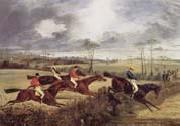 |
Henry Thomas Alken
|
|
1785-1851, Painter and engraver, son of Samuel Alken. He worked in London and the provinces and was prolific in a variety of media while unadventurous in his range of subject-matter. Early instruction by the miniature painter J. T. Beaumont (1774-1851) helped to give a certain graphic precision
|
|
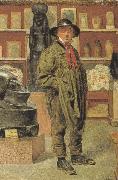 |
Henry stacy marks,R.A.
|
|
1829-1898
English painter. He studied with J. M. Leigh (1808-60) from 1847 and in January 1851 enrolled at the Royal Academy Schools. In 1852 Marks and P. H. Calderon spent five months studying in Paris under Fran?ois-Edouard Picot and at the Ecole des Beaux-Arts. The next year he made his d?but at the Royal Academy Summer Exhibition, where he exhibited annually until 1897. He was elected ARA in 1871 and RA in 1878.
|
|
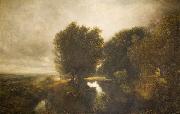 |
Henry Mark Anthony
|
|
(4 August 1817 - 1 December 1886) was an English landscape artist, often favourably compared to John Constable by critics. He exhibited at many major art institutions and travelled widely, being credited with introducing the en plein air style of painting to Britain.
|
|
|
|
|
|
|
|
|
|
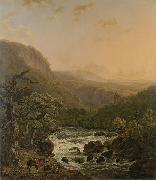 |
Henri van Assche
|
|
born at Brussels in 1774, showed from his earliest years a predilection for painting, and received from his father, who was a distinguished amateur artist, the first principles of design and perspective. He was afterwards placed with Deroy of Brussels, from whom he received further instructions in painting. Journeys in Switzerland and Italy contributed to develop his talent as a landscape painter. His great partiality for representing waterfalls, mountain streams, and mills gained for him the name of 'The Painter of Waterfalls.' Several pictures by him may be seen in public and private collections of Brussels, Ghent, Lille, and Haarlem, some of which are enriched with figures and animals by Ommeganck. He died at Brussels in 1841.
|
|
|
|
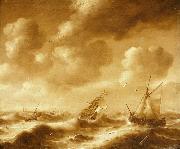 |
Hendrick van Anthonissen
|
|
(29 May 1605, Amsterdam - 12 November 1656, Amsterdam) was a Dutch marine painter.
Van Anthonissen was the son of Aert Anthonisz (a.k.a. Aart van Antum) and painted in the style of his brother-in-law and teacher Jan Porcellis and of Jan van Goyen. He is the author of sea paintings in the Hermitage, St. Petersburg and the Prague Gallery, which through their signatures have been ascribed to a mythical Hendrik van Antem. In the 1630's he lived in The Hague, Leiden, and Leiderdorp, but from 1642 he was back in Amsterdam. He is known for beach scenes and seascapes in the manner of Jan Porcellis, sometimes in grisaille. He was the father of the marine painter Arnoldus van Anthonissen.
|
|
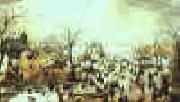 |
Hendrick Avercamp
|
|
1585-1634
Dutch
Hendrick Avercamp Galleries
Hendrick Avercamp (bapt. January 27, 1585, Amsterdam - buried May 15, 1634, Kampen (Overijssel)) was a Dutch painter.
Avercamp studied in Amsterdam with the Danish-born portrait painter Pieter Isaacks (1569-1625), and perhaps also with David Vinckbooms. In 1608 he moved from Amsterdam to Kampen in the province of Overijssel. Avercamp was deaf and was known as "de Stomme van Kampen" (the mute of Kampen).
As one of the first landscape painters of the 17th-century Dutch school, he specialized in painting the Netherlands in winter. Avercamp's paintings are colorful and lively, with carefully crafted images of the people in the landscape.
Avercamp's work enjoyed great popularity and he sold his drawings, many of which were tinted with water-color, as finished pictures to be pasted into the albums of collectors. Queen Elizabeth II has an outstanding collection of his works at Windsor Castle, England.
|
|
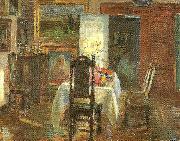 |
helga ancher
|
|
född 19 augusti 1883 i Skagen, död 18 mars 1964 i Skagen, var en dansk konstnär (målare).
Helga Ancher var dotter till konstnärerna Anna och Michael Ancher och förekommer som barn ofta som motiv i föräldrarnas målningar. Helga kom sedermera själv att utbilda sig till målare och studerade bland annat på Konstakademien i Köpenhamn samt i Tyskland, Frankrike och Italien. Även om hon aldrig blev blev lika känd för sin konst som sina föräldrar har en del av hennes tavlor kommit att betinga höga värden på auktioner.
Föräldrarnas hem i Skagen lät Helga Ancher efter moderns död 1935 bevara i det skick det hade då och skänkte sedermera detta till en stiftelse, vilken 1967 kunde öppna konstnärsbostaden som museum.
|
|
|
|
|
|
Helen Allingham,R,W.S
|
|
1848-1926
Studies of Flowers
Studies of Flowers .was a well-known watercolour painter and illustrator of the Victorian era. Helen Mary Elizabeth Paterson was born in Swadlincote in Derbyshire,[1] England. Her sister and her father, a doctor, died of diphtheria in 1862, and the rest of the family went to live in Birmingham. In 1867 she went to study art at the "Female School of Art", a section of what became the Royal College of Art in London, and became an illustrator of children's books. She was a great friend of Kate Greenaway. On 22 August 1874, she married William Allingham, who was almost twice her age. At the time, she was employed in illustrating some of the novels of Thomas Hardy, and they were attracted to one another when they met. Helen Allingham illustrated several books, including Six to sixteen: a story for girls (1876), Happy England (1903) and The homes of Tennyson (1905), written with her brother Arthur Paterson. After her marriage to Allingham, she became a watercolour painter, and she was the first woman to become a full member of the Royal Watercolour Society. As well as landscapes, she completed several portraits, including one of Thomas Carlyle.
|
|
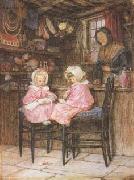 |
Helel Allingham,RWS
|
|
1848-1926
was a well-known watercolour painter and illustrator of the Victorian era. Helen Mary Elizabeth Paterson was born in Swadlincote in Derbyshire,[1] England. Her sister and her father, a doctor, died of diphtheria in 1862, and the rest of the family went to live in Birmingham. In 1867 she went to study art at the "Female School of Art", a section of what became the Royal College of Art in London, and became an illustrator of children's books. She was a great friend of Kate Greenaway. On 22 August 1874, she married William Allingham, who was almost twice her age. At the time, she was employed in illustrating some of the novels of Thomas Hardy, and they were attracted to one another when they met. Helen Allingham illustrated several books, including Six to sixteen: a story for girls (1876), Happy England (1903) and The homes of Tennyson (1905), written with her brother Arthur Paterson. After her marriage to Allingham, she became a watercolour painter, and she was the first woman to become a full member of the Royal Watercolour Society.
|
|
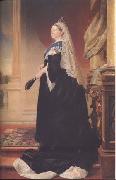 |
Heinrich von Angeli
|
|
1840 - 1925
Austrian painter. In 1853 he moved to Vienna to live with his uncle, who was a collector and a friend of the painters Friedrich von Amerling and Mathias Ranftl (1805-54). Angeli's early Self-portrait reflects the precocious maturity of his style, and in 1854 he enrolled at the Akademie der Bildenden K?nste in Vienna. In 1856, on the advice of Amerling, he went to study under Emanuel Gottlieb Leutze in D?sseldorf, where he executed one of his most significant history paintings, Mary Stuart Reading her Death Warrant (1857). In 1859 he moved to Munich, where he worked independently and was encouraged by Karl Theodor von Piloty, producing the history paintings Ludwig XI and Franz de Paula (1859) and Antony and Cleopatra for Ludwig I of Bavaria. In 1862 he again settled in Vienna, where he enjoyed increasing success. The life-size portrait of Baronin Seidler and the genre painting Avengers of Honour (1869), both exhibited at the Weltausstellung in Vienna in 1873, secured his reputation. After brief stays in Paris and Berlin (c. 1866), he went in 1871 to Italy, where he painted numerous portraits and the genre work Absolution Denied. His final genre paintings, Youthful Love (sold London, Sotheby's, 3 Oct 1980) and Calabrian Shepherd Couple, also date from this year. Henceforth he devoted himself entirely to portrait painting, receiving important commissions from such aristocratic circles as the Kinsky and Auersperg families (e.g. Graf Anton Alexander Auersperg, 1876; Vienna, Pr?sidium des Nationalrates). Whereas his early portraits were influenced by Amerling, Anton Einsle and 17th-century Dutch art, from the 1870s he developed his own elegant and restrained style. This helped him to obtain commissions at the courts of Vienna, St Petersburg and London
|
|
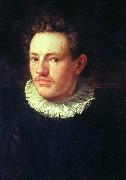 |
Hans von Aachen
|
|
was a German mannerist painter.
His name is derived from the birth place of his father, Aachen in Germany. Other variations of the name include Johann von - and - von Achen and various concisions like Janachen, Fanachen, Abak, Jean Dac, Aquano, van Aken etc.
Hans von Aachen began painting in Germany as a pupil of the Flemish master E. Jerrigh. He then moved to Italy in 1574 to study further. He toured Rome and Florence, but eventually settled in Venice. He initially became a pupil of Kaspar Rems, but soon decided to develop his own mannerist technique, by studying Tintoretto and Michelangelo's followers. However, during all of his life he was influenced by the style of Bartholomeus Spranger and Hendrick Goltzius who dominated the art scene in Germany at the time.
He returned to Germany in 1588 where he became well known as a painter of portraits for noble houses. He painted several works for Duke William V of Bavaria. He married Regina, the daughter of the composer Orlando di Lasso in Munich. In Munich he came into contact with the Imperial Court in Prague. In 1592 he was appointed official painter of Rudolph II, Holy Roman Emperor. However, Von Aachen only moved to Prague in 1601, where he stayed painting commissions from Emperor Rudolph II, and later from Matthias I.
Amongst van Aachens pupils were Peter Isaak and Joseph Heinz. His works have been copied by Wolfgang Kilian, Dominicus Custos and Jan Sadeler.
|
|
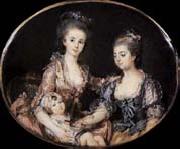 |
HALL, Peter Adolf
|
|
1739-1793
Swedish painter and collector. In 1753 he attended Uppsala Universitet to study medicine and natural history. In 1755 he went on a study trip abroad, led by his drawing-master Lars Brisman. While in Germany (1756-9) he studied miniature painting with Eichhardt in Berlin and with Karl Friedrich Wilhelm Richard (1725-70) in Hamburg. After this trip, he decided to become a professional portrait painter, and in 1759 he enrolled at the Kungliga Akademi for de Fria Konsterna in Stockholm, studying drawing with the French sculptor Pierre-Hubert Larchaveque (1721-78) and painting with Gustaf Lundberg. He attracted the attention of C. F. Adelcrantz, who in 1766 gained for him a commission for the pastel portrait of Princes Karl and Fredrik Adolf. In that year he also executed a miniature portrait of Crown Prince Gustav on the occasion of his engagement to Princess Sophia Magdalena of Denmark. Also in 1766 he received a royal travel grant to study in Paris, where he developed a completely new technique of miniature painting using sweeping brushwork and a clear and fresh range of colour that allowed for lively characterization. He made exquisite detailed studies of the backgrounds of his paintings, as well as his sitters costumes and their attributes and accessories. His new technique involved applying gouache to the ivory in a manner that allowed the ivory to show through, a method that was particularly successful in depicting drapery. The smooth surface of the ivory also allowed freer brushwork associated with full-scale portraits.
|
|
|
|
|
|
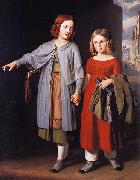 |
Gustav Adolph Hennig
|
|
Gustav Adolph Hennig (1797-1869)Professions: Historical-scenes painter; Porträtmaler; Miniature painter; Etcher; Lithographer.
|
|
|
|
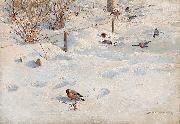 |
Gunnar aberg
|
|
Gunnar Berg (21 May 1863 -23 December 1893) was a Norwegian painter, known for his paintings of his native Lofoten. He principally painted memorable scenes of the everyday life of the local fishermen.
|
|
 |
GRIMMER, Abel
|
|
Flemish Baroque Era Painter, ca.1570-C.1619
Son of Jacob Grimmer. He married Catharina Lescornet on 29 September 1591 and in 1592 became a master in the Antwerp Guild of St Luke. He is principally known for his numerous small paintings of country scenes, sometimes with a biblical theme, which often form part of a series of the Four Seasons or the Months of the Year. Some of these paintings were inspired by or even copied from prints by Pieter Bruegel I and Hans Bol, both of whose work strongly influenced Abel, even more so than did the example of his father's work, which was also an important source of inspiration. Abel's series of the Twelve Months (1592; Montfaucon-en-Velay, Haute-Loire, Chapelle Notre-Dame) are exact copies of Adriaen Collaert's prints after Hans Bol (Hollstein: Dut. & Flem., iv, nos 523-34), published by Hans van Luyck ( fl c. 1580-85) in 1585. Spring and Summer (Antwerp, Kon. Mus. S. Kst.) are almost exact copies of two prints by Pieter van der Heyden
|
|
|
|
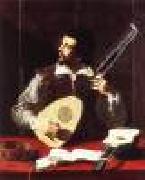 |
GRAMATICA, Antiveduto
|
|
Italian Baroque Era Painter, 1571-1626
Italian painter. He was from a Sienese family. According to Baglione, his parents were journeying from Siena to Rome when his mother went into labour and gave birth to him at an inn, an inconvenience that had been foreseen ('antiveduto') by his father and led to his unusual name. For a brief period he was a pupil of Giandomenico Angelini ( fl 1550-1600), under whom he painted small-scale works, mainly on copper. His prolific production of devotional paintings, portraits and copies of portraits won him swift success; in 1593 he became a member of the Accademia di S Luca and in 1604 of the Congregazione dei Virtuosi. His early portraits have not been identified; they included highly popular copies of a series of Famous Men then at the Villa Medici, works that Caravaggio probably also copied when he worked for some months in his studio on his arrival in Rome in 1592
|
|
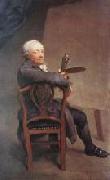 |
GRAFF, Anton
|
|
Swiss-born German Painter, 1736-1813
Swiss painter, active in Germany. He was a pupil of Johann Ulrich Schellenburg (1709-95) in Winterthur and continued his training with Johann Jakob Haid in Augsburg between 1756 and 1765. He worked for the court painter Leonhard Schneider (1716-62) in Ansbach from 1757 to 1759, producing large numbers of copies of a portrait of Frederick the Great (probably by Antoine Pesne). This was an important step in furthering his career, as were the months he spent in Regensburg (1764-5) painting miniatures of clerics and town councillors. He was court painter to the Elector Frederick-Christian of Saxe-Weimar in Dresden from 1766 and taught at the Hochschule der Bildende Kenste there. In 1771 he travelled to Berlin, where he painted portraits of Jakob Mendelssohn, Gotthold Ephraim Lessing and J. G. Sulzer. Sulzer introduced him at court, which resulted in many commissions. He was invited several times to teach at the Akademie der Kenste in Berlin, but he remained in Dresden. He often travelled to Leipzig, and in summer he frequently went to Teplitz
|
|
|
|
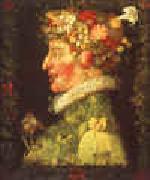 |
Giuseppe Arcimboldo
|
|
b.c. 1527, Milan,
d.1593, Milan Italian Giuseppe Arcimboldo Galleries
Arcimboldo was born in Milan in 1527, the son of Biagio, a painter who did work for the office of the Fabbrica in the Duomo.Arcimboldo was commissioned to do stained glass window designs beginning in 1549, including the Stories of St. Catherine of Alexandria vitrage at the Duomo. In 1556 he worked with Giuseppe Meda on frescoes for the Cathedral of Monza. In 1558, he drew the cartoon for a large tapestry of the Dormition of the Virgin Mary, which still hangs in the Como Cathedral today.
In 1562 he became court portraitist to Ferdinand I at the Habsburg court in Vienna, and later, to Maximilian II and his son Rudolf II at the court in Prague. He was also the court decorator and costume designer. King Augustus of Saxony, who visited Vienna in 1570 and 1573, saw Arcimboldo's work and commissioned a copy of his "The Four Seasons" which incorporates his own monarchic symbols.
Arcimboldo's conventional work, on traditional religious subjects, has fallen into oblivion, but his portraits of human heads made up of vegetables, fruit and tree roots, were greatly admired by his contemporaries and remain a source of fascination today. Art critics debate whether these paintings were whimsical or the product of a deranged mind.. A majority of scholars hold to the view, however, that given the Renaissance fascination with riddles, puzzles, and the bizarre (see, for example, the grotesque heads of Leonardo da Vinci, a fellow Milanese), Arcimboldo, far from being mentally imbalanced, catered to the taste of his times.
Arcimboldo died in Milan, to which he retired after leaving the Habsburg service. It was during this last phase of his career that he produced the composite portrait of Rudolph II (see above), as well as his self-portrait as the Four Seasons. His Italian contemporaries honored him with poetry and manuscripts celebrating his illustrious career. His hidden-face still-lives are a possible influence on his younger Lombard contemporary Caravaggio, whose painting of fruit in the Brera museum in Milan ranks as one of the earliest independent still-lives.
When the Swedish army invaded Prague in 1648, during the Thirty Years' War, many of Arcimboldo's paintings were taken from Rudolf II's collection.
His works can be found in Vienna's Kunsthistorisches Museum and the Habsburg Schloss Ambras in Innsbruck, the Louvre in Paris, as well as numerous museums in Sweden. In Italy, his work is in Cremona, Brescia, and the Uffizi Gallery in Florence. The Wadsworth Atheneum in Hartford, Connecticut, the Denver Art Museum in Denver, Colorado, the Menil Foundation in Houston, Texas, and the Candie Museum in Guernsey also own paintings by Archimboldo.
|
|
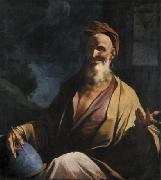 |
Giuseppe Antonio Petrini
|
|
(October 23, 1677- c. 1755-9) was a painter of the late-Baroque, active mainly in Lugano, present-day Switzerland.
St. Andrew
City Museum of Rimini, ItalyWhile born in Carona in Canton Ticino and died in Lugano, both in Switzerland, Petrini belongs to the Northern Italian or Lombard heritage of baroque painting. He possibly apprenticed with Bartolomeo Guidobono after 1700. While some works can be found in Como and Bergamo, most are located in Lugano and the surrounding area. He is also listed between 1711 and 1753 as fabbriciere of the church of Madonna deOnegro in Carona. He often painted "portraits" of historical figures including saints, philosophers, and scientists for patrons. One of his more prominent examples is his depiction of an auster St. Peter emerging from the shadows to pinpoint some lines in the gospel. He painted another St. Peter for the parish church of Dubino. Pietro Ligari classified him among the speculative painters, since these portraits, by nature, were imagined.
|
|
 |
Giuseppe Abbati
|
|
Italian, 1836-1868
Abbati was born in Naples and received early training in painting from his brother Vincenzo. He participated in Garibaldi 1860 campaign, suffering the loss of his right eye at the Battle of Capua. Afterwards he moved to Florence where, at the Caffe Michelangiolo, he met Giovanni Fattori, Silvestro Lega, and the rest of the artists who would soon be dubbed the Macchiaioli.
While his early paintings were interiors, he quickly became attracted to the practice of painting landscapes en plein air. His activity as a painter was interrupted during 1866 when he enlisted again in the army for the Third Independence War, during which he was captured by the Austrians and held in Croatia.
Returning to civilian life at the end of the year, he moved to Castelnuovo della Misericordia and spent the final year of his life painting in the countryside. Abbati died at the age of thirty-two in Florence after his own dog bit him, infecting him with rabies.
Giuseppe Abbati, The Tower of the Palazzo del Podesta, 1865, oil on wood, 39 x 32 cm.His paintings are characterized by a bold treatment of light effects. He often painted a luminous landscape scene as seen through the doorway of a darkened interior, as in the View from the Wine Cellar of Diego Martelli (1866). Some of his late landscapes are in the greatly elongated horizontal format often favored by the Macchiaioli.
|
|
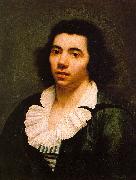 |
Girodet-Trioson, Anne-Louis
|
|
French Neoclassical Painter, 1767-1824
French painter. Originally named Girodet de Roussy or Roucy, he was a student of J.-L. David, and his classical training was sometimes at variance with his often eccentrically romantic expression. He won the Prix de Rome and while in Italy painted the Sleep of Endymion (1791; Louvre), a sensual and erotically ambiguous work that brought him widespread recognition. His Deluge (Louvre) demonstrates Girodet's interest in unusual color and lighting problems. Much of his work, including a series for Malmaison (Napoleon's residence), glorifies Napoleon.
|
|
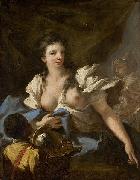 |
Giovanni Antonio Pellegrini
|
|
(29 April 1675 -- November 1741) was a widely-travelled Rococo decorative painter from Venice, where he was born and died. He is considered to be one of the most important Venetian painters of the early 18th century, melding the Renaissance style of Paolo Veronese with the Baroque of Pietro da Cortona and Luca Giordano,and is considered an important predecessor of Giovanni Battista Tiepolo. One of his pupils was Antonio Visentini.
Pellegrini's father, also Antonio, was a shoemaker from Padua. Pellegrini first studied under Girolamo Genga, but was later a pupil of Paolo Pagani and of Sebastiano Ricci. He married Angela Carriera, the sister of Rosalba Carriera, in c.1704. Pellegrini decorated the dome above the staircase at the Scuola Grande di San Rocco in 1709.
He is mainly known for his work in England, which he visited from 1708 to 1713 at the invitation of the Earl of Manchester, and where he had considerable success. He painted murals in a number of English country houses, including Castle Howard (mostly destroyed in 1940) and Kimbolton Castle, Narford Hall, and in London, 31 St James's Square for the Duke of Portland, where George Vertue noted in his notebooks "the hall and Staircase and one or two of the great rooms". He became a director of Sir Godfrey Kneller's Academy in London in 1711. He submitted designs for the decorating the interior dome of the new St Paul's Cathedral, and is said to have been Christopher Wren's favourite painter, but did not win the commission, losing out to Sir James Thornhill.
|
|
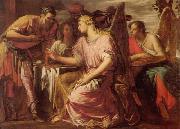 |
Giovanni Antonio Fumiani
|
|
(1645-1710) was an Italian painter of the Baroque period.
Born in Venice in 1645, he trained in Bologna under Domenico degli Ambrogi, a specialist in quadratura, but by 1668 he was back in Venice, where he painted a Virgin and Saints in San Benedetto. He was influenced by Ludovico Carracci and Alessandro Tiarini, and soon also became interested in the work of Paolo Veronese, so that he started to use elaborate architectural settings and brighter colours. He painted a Virgin Appearing to Pius V (1674; Vicenza, S Lorenzo), whose monumentality foreshadows Tiepolo, whereas mosaics in San Marco, created in 1677 from Fumianies cartoons, are closer to the idiosyncratic art of Pietro della Vecchia. He contributed to the decoration of San Rocco (1675, 1676, 1678), where he painted a large canvas of the Charity of St Roch on the ceiling of the nave, In his smaller paintings, however, such as the modelli (Florence, Uffizi) painted for the Ferdinand de Medici, Grand Prince of Tuscany, for whom he worked for a long time, with Niccole Cassana acting as intermediary, Fumiani revealed a lively decorative sense and a taste for animated, sensual subjects that produced works of great quality. His last work is the large lunette depicting Frederick III visiting St Zacharyes Convent in the Company of the Doge (Venice, San Zaccaria).
The decoration of San Pantalon with scenes from the Life of St Pantaleon (1680-1704) utilized canvases to cover a large ceiling (25x50 m), an ambitious undertaking, both in its scale and in the unity of the magniloquent images, that parallels Andrea Pozzoes decoration at the church of Sant'Ignazio in Rome. Fumiani was responsible for painting what is claimed to the largest painting on canvas in the world and covers the whole of the ceiling of the church Chiesa di San Pantaleone Martire, known as San Pantalon, in Venice. The painting depicts The Martyrdom and Apotheosis of St Pantalon, which he painted from 1680 until 1704. He putatively died from a fall from a scaffold, although some sources date his death to six years after he stopped work on the canvas
|
|
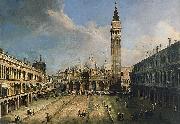 |
Giovanni Antonio Canal
|
|
(28 October 1697 - 19 April 1768) better known as Canaletto, was a Venetian painter famous for his landscapes, or vedute, of Venice. He was also an important printmaker in etching.
He was born in Venice as the son of the painter Bernardo Canal, hence his mononym Canaletto ("little Canal"), and Artemisia Barbieri. His nephew and pupil Bernardo Bellotto was also an accomplished landscape painter, with a similar painting style, and sometimes used the name "Canaletto" to advance his own career, particularly in countrieseGermany and Polandewhere his uncle was not active.
|
|
 |
Giovanni Antonio Boltraffio
|
|
was an Italian painter of the High Renaissance from Lombardy, who worked in the studio of Leonardo da Vinci.[2] Boltraffio and Bernardino Luini are the strongest artistic personalities to emerge from Leonardo's studio. According to Giorgio Vasari, he was of an aristocratic family and was born in Milan.
His major painting of the 1490s is the Resurrection (painted with fellow da Vinci pupil Marco d'Oggiono and now in the Gemäldegalerie, Berlin). A Madonna and Child in the Museo Poldi Pezzoli of Milan, is one of the high points of the Lombard Quattrocento.
His portraits, often in profile, and his half-length renderings of the Madonna and Child are Leonardesque in conception, though the clean hard edges of his outlines lack Leonardo's sfumato.
In Bologna, where he remained in 1500-1502, he found sympathetic patrons in the Casio family, of whom he painted several portraits and for whom he produced his masterwork, the Pala Casio for the Church of the Misericordia (Louvre Museum); it depicts a Madonna and Child with John the Baptist and Saint Sebastian and two Kneeling Donors, Giacomo Marchione de' Pandolfi da Casio and his son, the Bolognese poet Girolamo Casio[3], who mentioned Boltraffio in some of his sonnets. Boltraffio's portrait of Girolamo Casio is at the Pinacoteca di Brera, Milan.
|
|
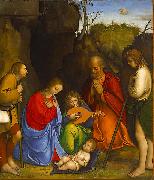 |
Giovanni Agostino da Lodi
|
|
was an Italian painter who was active from c. 1495 to c. 1525.
The attribution of his works has been dubious for centuries, until his style and career was defined by the American art historian Bernard Berenson in the 1960s. One of his first identified work is the Pala dei Barcaioli ("Boatmen Altarpiece") in the church of San Pietro Martire at Murano. His only signed work is the St. Peter and St. John the Evangelist in the Pinacoteca di Brera, which shows Lombard influeces, such as that of Bramantino.
Later he was also influenced by Leonardo da Vinci's style, as visible in the Christ Washing the Feet of the Apostles in the Gallerie dell'Accademia of Venice. After moving to Venice in the wake of Ludovico Sforza's fall, he returned to Milan in 1506. He subsequently executed works for privates and for the Certosa di Pavia; one of his late works, the Calvary, is housed in the National Gallery in Prague. He also collaborated with Marco d'Oggiono for a polyptych in the church of Santa Maria della Pace in Milan, some panels of which are now in the Pinacoteca di Brera.
|
|
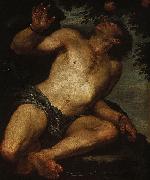 |
Gioacchino Assereto
|
|
(1600 - 28 June 1649) was an Italian painter of the early Baroque period, active in Genoa.
Gioacchino Assereto, David with the Head of Goliath.He initially apprenticed with Luciano Borzone and later Giovanni Andrea Ansaldo. He painted two vault frescoes in the church of Santissima Annunziata del Vastato: David and Abimelech and Santi Giovanni and Pietro healing the lame. He also shows the influence of Bernardo Strozzi, a tenebrism moderated by venetian coloristic effects and garbing the subjects in modern peasant garb, in paintings such as Moses obtaining water from the Rock (Prado Museum, Madrid). Orazio dee Ferrari may have worked with Assereto in Ansaldoes studio.
Paintings by Gioacchino Assereto can also be seen at the Detroit Institute of Art and the Museum of Fine Arts in Budapest,Hungary.
|
|
|
|
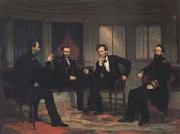 |
George P.A.Healy
|
|
American Painter, 1813-1894
American painter, active also in Europe. At the age of 17 he set up a studio in Boston after receiving encouragement from Thomas Sully, who was painting portraits there. Despite his youth and lack of training, he presented himself to the society figure Mrs Harrison Gray Otis and asked if he might paint her portrait (untraced); she agreed and later sponsored Healy's first trip abroad. In 1834 he entered the studio of Antoine-Jean Gros; the French master's suicide the following year ended Healy's only sustained period of artistic study. In Gros's studio he first encountered Thomas Couture, but they did not meet again until the next decade
|
|
|
|
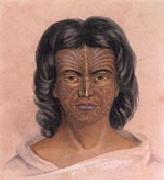 |
George French Angas
|
|
(1844-1932), was a portrait painter.
was an English explorer, naturalist and painter. He was the eldest son of George Fife Angas, prominent in the establishment of the new colony of South Australia. Despite showing remarkable talent in drawing, he was placed in a London business house by his father. He left on a tour of Europe and in 1842 published his first book, "Rambles in Malta and Sicily". As a result of this experience, he turned his back on the world of commerce, and directed his training towards a study of natural history, anatomical drawing and lithography. Embarking on his travels, he was soon to find his acquired skills extremely useful. Angas painted some of the earliest views of South Australia. Arriving in Adelaide in January 1844, he joined Sir George Grey on an expedition into the interior. He soon began an extensive series of journeys to the Murray River lakes, Barossa Valley, Fleurieu Peninsula and the South East, presenting his impressions of the newly established colony ?C its inhabitants, landscape, and its flora and fauna. Following a trip to New Zealand he returned to South Australia in 1845 and travelled to Port Lincoln. In the following year he returned for a short while to England. His next journey in 1846 was to South Africa, where he spent two years in Natal and the Cape, working on a series of drawings and watercolours which were published in 1849 as The Kafirs Illustrated. In this book were views of Cape Town, Durban, Wynberg, Genadendal, Paarl and Somerset West and plates depicting the local ethnic groups such as Hottentots, Malays and Zulus. He married Alicia Mary Moran in 1849, the marriage producing four daughters. In 1853 he was appointed to a position at the Australian Museum in Sydney, eventually becoming Director and staying a total of seven years. He was in Sydney when gold was first discovered near Bathurst, New South Wales. Travelling there to record the gold diggings he executed a number of drawings of the scenes that he found. These were published in Sydney and subsequently in London. Angas returned to South Australia in 1860, and finally went back to England in 1863.
|
|
|
|
|
|
|
|
|
|
|
|
|
| Wholesale China Oil Painting Wholesale Oil Painting China Xiamen Portrait Reproduction on canvas Chinese Oil Painting Wholesale USA Oil Painting |
|
|
|
|
|